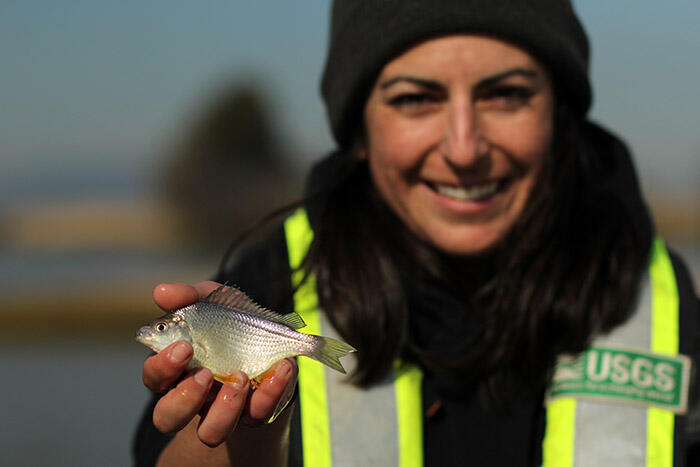USGS Interdisciplinary Science Contributes to Native Fish Ecology Efforts in the Delta
With the development of the Central Valley (CVP) and State Water (SWP) projects, the natural flow of the Sacramento-San Joaquin Delta has been reengineered to provide water for California’s growing population and agricultural needs. These changes have drastically reduced natural wetlands, affecting the habitat of native fish species, including the threatened Delta Smelt. To address the situation, joint operations of the CVP and SWP must balance human water demands on the Delta with protection of its fragile ecosystem and species of concern, especially those listed as threatened or endangered under state and federal laws.
To assist with this effort, the U.S. Bureau of Reclamation a has engaged the USGS to help better understand and promote habitats that are conducive to reestablishing the Delta Smelt and other native fish. The science employed will also be used to inform water management decisions that balance water delivery obligations with protecting species of concern.
To this end, for the past two years, an interdisciplinary team of scientists from the USGS California Water Science Center (CAWSC), the Water Mission in Menlo Park, and other USGS offices have been gathering data in the Little Holland Tract region of the Sacramento-San Joaquin Delta (Figure 1). The team is collecting data on a diverse set of information including: hydrodynamics, water quality, aquatic ecology, and benthic ecology (ecology relating to the bottom of a body of water).
Hydrodynamic Data
To understand how fish, nutrients, and water quality constituents are transported through the system, it is important to understand how Delta water is moving. To document the underlying mechanics of how water in this complex system moves, the USGS Estuarine Hydrodyanmics Team is collecting flow information using acoustic Doppler velocity meters at critical locations. Tides, regional hydrology, and complex geomorphology all impact the flow patterns and timing in this region.
Water Quality Data
At many of the fixed monitoring stations in the Delta, water quality data is being collected using multi-parameter sondes -- a type of sensor that measures temperature, specific conductance, and turbidity. At several critical locations, an expanded suite of water-quality characteristics is also being measured, including pH, dissolved oxygen, chlorophyll a, and dissolved organic material. These data provide further insight into the different aquatic habitats.
Aquatic Ecology
CAWSC’s Aquatic Ecology group will count and record current fish populations. This is important in that it indicates which species are increasing and which are not. These data are used in concert with water quality and hydrodynamics information to corroborate which ecological conditions best benefit native fish.
Phytoplankton (microscopic plant) and zooplankton (microscopic organism) densities will also be measured. These comprise the bottom of the food web. Zooplankton consume phytoplankton. Zooplankton are, in turn, a primary food source for certain fish species. Measuring the abundance of phytoplankton and zooplankton serve as indicators of healthy fish habitats.
Benthic Ecology
Another team, from the USGS Menlo Park office, will monitor invasive clam populations. Invasive clams were introduced to the Delta when boats from overseas emptied their bilges in the estuary and also by people bringing them to California as a food source. Monitoring invasive clams is important because they can consume foods that would otherwise benefit fishes of concern.
The objectives of these studies are to provide information to evaluate the success of ongoing management actions aimed at protecting and restoring Delta habitats while maintaining water supply reliability. Once final analysis and reporting are complete, the information will be available on this website.
Get Our News
These items are in the RSS feed format (Really Simple Syndication) based on categories such as topics, locations, and more. You can install and RSS reader browser extension, software, or use a third-party service to receive immediate news updates depending on the feed that you have added. If you click the feed links below, they may look strange because they are simply XML code. An RSS reader can easily read this code and push out a notification to you when something new is posted to our site.




